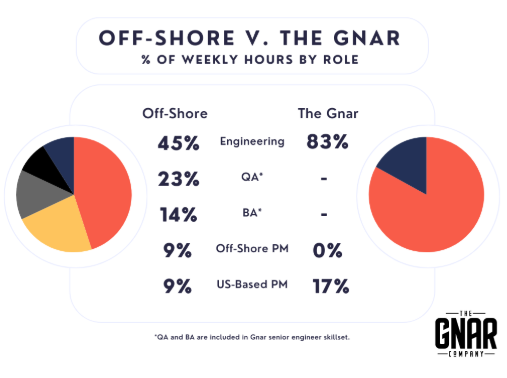It’s not the hourly rate, it’s where your money actually goes.
When choosing a development partner, most companies compare hourly rates. But the real question isn’t how much per hour? It’s how much of your budget actually goes to development?
It’s a metric we track closely to make sure we’re maximizing value for our clients, so it was shocking when we recently reviewed an actual offshore estimate for a software build with full fidelity Figma designs. While the rates looked low on the surface, only 37% of the budget was going toward actual development. The rest? Extra layers of management, inefficiencies, and hidden overhead.
For Every $100,000 You Spend:
Offshore: Only $37,000 builds your product - everything else goes elsewhere.
The Gnar: $72,000 goes directly to development - nearly double the value.
Here’s a different way to look at it, breaking down the same estimate by hours per role.
Where Your Budget Actually Goes Matters
Here’s why budget allocation impacts your project’s success:
- More budget for development means faster time-to-market – Delays cost real money.
- A dedicated team leads to higher quality – Our engineers work on one project at a time. Offshore teams? You’re often paying for teams juggling multiple.
- You might be paying for their management – The offshore estimate we saw included two project managers for a small scope! We assign one only if needed.
- Know what’s actually included – Cultural and time zone gaps lead to costly misunderstandings and revisions that you end up paying for. The Gnar stands by its work with a 12-month bug-free warranty.
Before You Sign, Ask Yourself (or them):
- What percentage of my budget actually funds development work?
- Will my engineers be fully dedicated to my project?
- Who’s accountable for quality and meeting deadlines?
- What’s the hidden cost of inefficiencies and rework?
It’s easy to be tempted by low hourly rates. But in software development, what you pay for matters more than what you pay per hour.
Also, if you liked this article please subscribe to our newsletter

